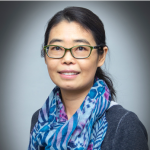1 Yongjie Jessica Zhang, 2021 SMA Fellow
 Jessica Zhang is the George Tallman Ladd and Florence Barrett Ladd Professor of Mechanical Engineering at Carnegie Mellon University (CMU) with a courtesy appointment in Biomedical Engineering. Her research focuses on computational geometry, mesh generation, isogeometric analysis (IGA), finite element method, data-driven simulation, image processing with broad applications in computational biomedicine, materials science and engineering. She has created the first systematic computational framework for high-fidelity geometric modeling and mesh generation with unique features different from other existing methods: image-based meshing for heterogeneous domains with topology ambiguity resolved; multiscale geometric modeling for biomolecular complexes; all-hexahedral meshing with sharp feature preservation; and robust quality improvement for non-manifold meshes. Jessica’s pioneering research on analysis-suitable volumetric spline modeling contributed directly to the integration of design and analysis, the root idea of IGA, leading to great advances in computational mechanics. Her unique spline modeling techniques have been incorporated into commercial software such as Rhino, Abaqus and LS-DYNA. Jessica has made significant contributions to broad engineering applications: material transport simulation in complex neurite structures, multiscale modeling for Ca2+ signaling in ventricular myocytes; cubic Hermite cardiac model construction; dynamic lung modeling and tumor tracking for image-guided radiotherapy; and critical feature determination of polycrystalline materials. She has been leading new research effort of combining physics-based modeling with machine learning to explore novel applications in neuron computation and additive manufacturing. Jessica’s research provides engineers/scientists with novel technologies to construct high-fidelity, multiscale models for complicated domains, which will dramatically advance our predictive capability of physical/biological phenomena at molecular, cellular, tissue and organ scales. Jessica is the recipient of Simons Visiting Professorship from Mathematisches Forschungsinstitut Oberwolfach of Germany, US Presidential Early Career Award for Scientists and Engineers, NSF CAREER Award, Office of Naval Research Young Investigator Award, and USACM Gallagher Young Investigator Award. At CMU, she received David P. Casasent Outstanding Research Award, George Tallman Ladd and Florence Barrett Ladd Professorship, Clarence H. Adamson Career Faculty Fellow in Mechanical Engineering, Donald L. & Rhonda Struminger Faculty Fellow, and George Tallman Ladd Research Award. She is a Fellow of AIMBE, ASME, USACM and ELATES at Drexel.
Jessica Zhang is the George Tallman Ladd and Florence Barrett Ladd Professor of Mechanical Engineering at Carnegie Mellon University (CMU) with a courtesy appointment in Biomedical Engineering. Her research focuses on computational geometry, mesh generation, isogeometric analysis (IGA), finite element method, data-driven simulation, image processing with broad applications in computational biomedicine, materials science and engineering. She has created the first systematic computational framework for high-fidelity geometric modeling and mesh generation with unique features different from other existing methods: image-based meshing for heterogeneous domains with topology ambiguity resolved; multiscale geometric modeling for biomolecular complexes; all-hexahedral meshing with sharp feature preservation; and robust quality improvement for non-manifold meshes. Jessica’s pioneering research on analysis-suitable volumetric spline modeling contributed directly to the integration of design and analysis, the root idea of IGA, leading to great advances in computational mechanics. Her unique spline modeling techniques have been incorporated into commercial software such as Rhino, Abaqus and LS-DYNA. Jessica has made significant contributions to broad engineering applications: material transport simulation in complex neurite structures, multiscale modeling for Ca2+ signaling in ventricular myocytes; cubic Hermite cardiac model construction; dynamic lung modeling and tumor tracking for image-guided radiotherapy; and critical feature determination of polycrystalline materials. She has been leading new research effort of combining physics-based modeling with machine learning to explore novel applications in neuron computation and additive manufacturing. Jessica’s research provides engineers/scientists with novel technologies to construct high-fidelity, multiscale models for complicated domains, which will dramatically advance our predictive capability of physical/biological phenomena at molecular, cellular, tissue and organ scales. Jessica is the recipient of Simons Visiting Professorship from Mathematisches Forschungsinstitut Oberwolfach of Germany, US Presidential Early Career Award for Scientists and Engineers, NSF CAREER Award, Office of Naval Research Young Investigator Award, and USACM Gallagher Young Investigator Award. At CMU, she received David P. Casasent Outstanding Research Award, George Tallman Ladd and Florence Barrett Ladd Professorship, Clarence H. Adamson Career Faculty Fellow in Mechanical Engineering, Donald L. & Rhonda Struminger Faculty Fellow, and George Tallman Ladd Research Award. She is a Fellow of AIMBE, ASME, USACM and ELATES at Drexel.
2 Satyandra Kumar Gupta, 2021 SMA Fellow
 SK Gupta has made several ground-breaking research contributions in the robotics and automation areas. He has developed algorithms to analyze 3D models, extract relevant features from the models, and perform geometric reasoning to enable automated manufacturability analysis, tool design, process planning, and motion planning in manufacturing applications. He has developed algorithms for automated manufacturability analysis for machined parts by considering alternative feature-based interpretations and utilizing closed-loop integration of feature recognition and plan evaluation steps to handle complex parts with interacting features. He has developed a generative process planning system for automatically generating plans for complex sheet metal parts. This approach involves explicitly extracting tooling and setup constraints from geometric models and uses these constraints to generate shared setups that can be used to produce many different types of parts without requiring a setup change. He also developed a new representation to enable caching results of previously performed geometric computations during planning. Software based on this algorithm was commercialized by Amada, a press-brake manufacturer in Japan. His group has developed algorithms for automated design of molds based on accessibility analysis. These algorithms have been applied to automatically generate molds for multi-piece molding, multi-stage molding, and in-mold assembly processes. This work was used to realize a wide variety of new design concepts from bio-inspired robots to polymer heat exchangers. His group has developed an automated optical micro manipulation system called Optical Hand. This technology has significantly reduced the time needed to conduct experiments and minimize damage to cells. His group has developed algorithms for solving path-constrained manipulator motion planning problems by utilizing adaptive geometric representations and successive application of constraints. This work serves as a foundation for realizing smart robotic assistants in manufacturing applications. This technology has been demonstrated in applications such as robotic sanding, conformal additive manufacturing, and automated composite prepreg sheet layup. has authored more than four hundred articles in journals, conference proceedings, and book chapters. He has delivered more than one hundred and fifty invited seminars and lectures.
SK Gupta has made several ground-breaking research contributions in the robotics and automation areas. He has developed algorithms to analyze 3D models, extract relevant features from the models, and perform geometric reasoning to enable automated manufacturability analysis, tool design, process planning, and motion planning in manufacturing applications. He has developed algorithms for automated manufacturability analysis for machined parts by considering alternative feature-based interpretations and utilizing closed-loop integration of feature recognition and plan evaluation steps to handle complex parts with interacting features. He has developed a generative process planning system for automatically generating plans for complex sheet metal parts. This approach involves explicitly extracting tooling and setup constraints from geometric models and uses these constraints to generate shared setups that can be used to produce many different types of parts without requiring a setup change. He also developed a new representation to enable caching results of previously performed geometric computations during planning. Software based on this algorithm was commercialized by Amada, a press-brake manufacturer in Japan. His group has developed algorithms for automated design of molds based on accessibility analysis. These algorithms have been applied to automatically generate molds for multi-piece molding, multi-stage molding, and in-mold assembly processes. This work was used to realize a wide variety of new design concepts from bio-inspired robots to polymer heat exchangers. His group has developed an automated optical micro manipulation system called Optical Hand. This technology has significantly reduced the time needed to conduct experiments and minimize damage to cells. His group has developed algorithms for solving path-constrained manipulator motion planning problems by utilizing adaptive geometric representations and successive application of constraints. This work serves as a foundation for realizing smart robotic assistants in manufacturing applications. This technology has been demonstrated in applications such as robotic sanding, conformal additive manufacturing, and automated composite prepreg sheet layup. has authored more than four hundred articles in journals, conference proceedings, and book chapters. He has delivered more than one hundred and fifty invited seminars and lectures.
3 Rida Farouki, 2021 Bézier Award Recipient
 Rida Farouki is famous for his introduction of Pythagorean hodograph (PH) curves in 1990 and his successive extensive research on these curves. Already prior to that, he had been a highly respected researcher in Computer-Aided Geometric Design (CAGD), especially known for his work on the numerical stability of the Bernstein form and on the interplay of algebraic and differential geometry in CAGD, in connection with offsets, surface-surfaces intersections and shape analysis. It is exactly this interplay where PH curves enter the scene. Polynomial PH curves are characterized by a polynomial arc length function. Note that an arc length parameterization is the preferred tool in Differential Geometry of curves, while rational parameterizations are studied in Algebraic Geometry. Linking these fields has been highly novel and led to many surprising and elegant results, from a purely mathematical perspective and from the perspective of applications in various manufacturing processes. The theoretical results include explicit representations of PH curves using complex numbers (for 2D curves) or quaternions (in 3D), complete classifications of the low degree cases (the most practical ones), approaches to design and approximation with these curves, to name just some of the many contributions. Some properties of PH curves laid the basis for entire series of papers by other researchers in the field, an example of that being the many studies on rational curves and surfaces with rational offsets. It would lead too far to just outline here the impact of this seminal work by Farouki. Convincing support for this claim is provided by Farouki’s book “Pythagorean-Hodograph Curves” which appeared as Volume 1 in the Springer Series “Geometry and Computing” (2008) and lists nearly 500 references related to the topic. In the meanwhile, the number of articles on or closely related to this subject may well have doubled.
Rida Farouki is famous for his introduction of Pythagorean hodograph (PH) curves in 1990 and his successive extensive research on these curves. Already prior to that, he had been a highly respected researcher in Computer-Aided Geometric Design (CAGD), especially known for his work on the numerical stability of the Bernstein form and on the interplay of algebraic and differential geometry in CAGD, in connection with offsets, surface-surfaces intersections and shape analysis. It is exactly this interplay where PH curves enter the scene. Polynomial PH curves are characterized by a polynomial arc length function. Note that an arc length parameterization is the preferred tool in Differential Geometry of curves, while rational parameterizations are studied in Algebraic Geometry. Linking these fields has been highly novel and led to many surprising and elegant results, from a purely mathematical perspective and from the perspective of applications in various manufacturing processes. The theoretical results include explicit representations of PH curves using complex numbers (for 2D curves) or quaternions (in 3D), complete classifications of the low degree cases (the most practical ones), approaches to design and approximation with these curves, to name just some of the many contributions. Some properties of PH curves laid the basis for entire series of papers by other researchers in the field, an example of that being the many studies on rational curves and surfaces with rational offsets. It would lead too far to just outline here the impact of this seminal work by Farouki. Convincing support for this claim is provided by Farouki’s book “Pythagorean-Hodograph Curves” which appeared as Volume 1 in the Springer Series “Geometry and Computing” (2008) and lists nearly 500 references related to the topic. In the meanwhile, the number of articles on or closely related to this subject may well have doubled.
